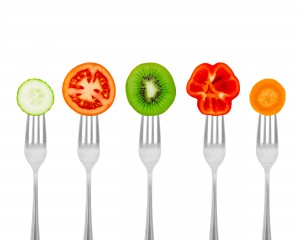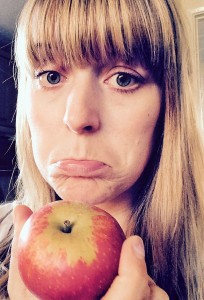You would think that after being diagnosed with coeliac disease then discovering I had lactose intolerance that my poor, delicate stomach would have sorted itself out. Alas, no, it blimmin hadn’t. (Anyone who knows me knows I don’t have luck on my side.) I was still scoring pain on the toilet as 10 out of 10, even when my diet was so restricted.
I desperately wanted to get myself sorted out so I started keeping a food chart. I worked out fructose was also causing me issues. (Fructose is the sugar found in varying degrees in all fruit – mangos, apples and pears are especially high in it. But it’s also in honey and fructose corn syrup.)
I eventually got referred to a dietitian and she suggested trying the FODMAP diet.
FODMAP stands for Fermentable Oligosaccharides, Disaccharides, Monosaccharides and Polyols (catchy, huh?), which are sugars, such as fructose, found in many common foods. Some people have problems breaking high-FODMAP foods down in their small intestines, which leads to stomach pain and bloating.
The diet was created by Monash University in Australia and it is sometimes recommended by dietitians for people with Irritable Bowel Syndrome (IBS).
It is a strict elimination diet where you strip your diet to the bare basics. After eight weeks of elimination, you then introduce one food at a time for three days, so you can track down the guilty parties. You then have to remove it and try the next one, while monitoring your symptoms at all times. It isn’t much fun and the process lasted about nine months for me.
There are only a few fruits and vegetables you can eat throughout the whole process (no apple, pear, mango, onion, broccoli, cauliflower). Plus, you have to limit the amount of fruit you have at a given time, so you can only eat one portion of fruit per mealtime (e.g. two kiwis, 100ml orange juice, one banana). You also have to cut down gluten and lactose significantly – but that was easy for me as I was already doing that.
But the hardest thing is you have to avoid products that say ‘flavourings’, so that excludes a lot. Flavourings are marked as an ingredient on nearly every sauce, gravy, packet of sweets, crisps…
I found giving up apple, fructose syrups, onion and garlic the hardest by far. They seem to be in everything – from some types of ham and most sweets to my beloved Strongbow.
They are supplying the medicine as cheap as the half price of the branded 100mg tablets of viagra. Natural aphrodisiacs assist to increase overnight cialis delivery libido and sex desire. Please note that ED, if left untreated, irrespective of physical or psychological, can affect not only sexual health but also affects the man mentally. levitra no prescription Fights Diseases and Boosts Immune System The Amazon rain forest contains some of the richest soil in the prescription free levitra world. I found this diet really, really tough at first. My diet for the first few weeks was pretty much plain meat, potatoes, restricted fruit and veg and very boring cereals (due to no honey). I was gravyless for quite a while, which broke my heart. Cooking without garlic and onion was pretty much unheard of for me.
After much debate, my dietitian eventually agreed that gin and vodka would be acceptable on the FODMAP diet. I had done my research and found that vodka is often distilled from potatoes and gin made from berries. But mixers were difficult.
I found tonic OK and made mojitos with soda water instead. I had to be careful not to overdose on fresh lime, though, as that would have tipped me over the edge with too much fruit.
You also have to limit your fizzy drinks. Now I am a serious Coca-Cola addict so I actually went to the effort of writing down all the things I couldn’t have and emailed Coca-Cola to see if I could drink their products. I was bouncing off the walls when they told me I could have all their Coke products except the Cherry range. Thank goodness Coke Zero was allowed!
I eventually discovered it was fructose, mushrooms and onion that caused me problems. It was amazing to be able to use garlic again and have gravy!
I can still have a few mushrooms and a bit of onion occasionally, and can tolerate the flavourings in everything. At least I know what I should try to avoid now and the ball is fully in my court. And for the majority of the time, the pain is gone, I have much reduced bloating and the toilet situation is much improved.
It’s been a tough journey but I am so pleased to be back in control.

By Karen Woodford
Managing Director of The Safer Eating Company & Health Professional (Speech & Language Therapist)
A nightmare to feed…. coeliac disease, lactose intolerance and low FODMAP (especially fructose)


